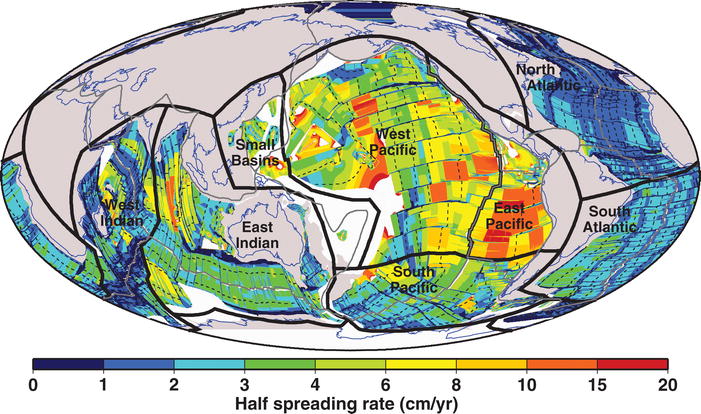

Indirect observation
Spreading rates:
How fast is new seafloor being produced at midocean ridges?
How fast is the repaving? The rate at which seafloor is produced is called the spreading rate. Because seafloor is produced to both sides of the midocean ridges, the full spreading rate is about twice that to one side, or the half-spreading rate.
What does the spreading rate matter? The rate of motion of the Pacific plate is generally the half-spresading rate for the East Pacific Rise. That motion of spreading is the rate of motion along the San Andreas Fault.

Questions for thought
How fast is new seafloor being produced at midocean ridges?
Half-spreading rate at time oceanic lithosphere was originally produced
Credits and sources:
Map: Half-spreading rates
Scientific paper:
Conrad and Carolina Lithgow-Bertelloni, 2007. Faster seafloor spreading and lithosphere production during the mid-Cenozoic. Geology, 35:29–32.

New seafloor is produced out of midocean ridges. It comes hot out of the Earh and paves the width of the entire seafloor to each side of midocean ridges. It not only looks like a conveyor belt system, but what's produced is the "belt" or moving flat surface of the conveyor. Anything that falls on that surface gets carried along away from midocean ridges.Credits and sources:
Map: Half-spreading rates
Scientific paper:
Conrad and Carolina Lithgow-Bertelloni, 2007. Faster seafloor spreading and lithosphere production during the mid-Cenozoic. Geology, 35:29–32.
How fast is the repaving? The rate at which seafloor is produced is called the spreading rate. Because seafloor is produced to both sides of the midocean ridges, the full spreading rate is about twice that to one side, or the half-spreading rate.
What does the spreading rate matter? The rate of motion of the Pacific plate is generally the half-spresading rate for the East Pacific Rise. That motion of spreading is the rate of motion along the San Andreas Fault.

Questions for thought
- How fast is overall motion along the San Andreas Fault?
- How long will it be before San Diego and Oakland are neighbors?